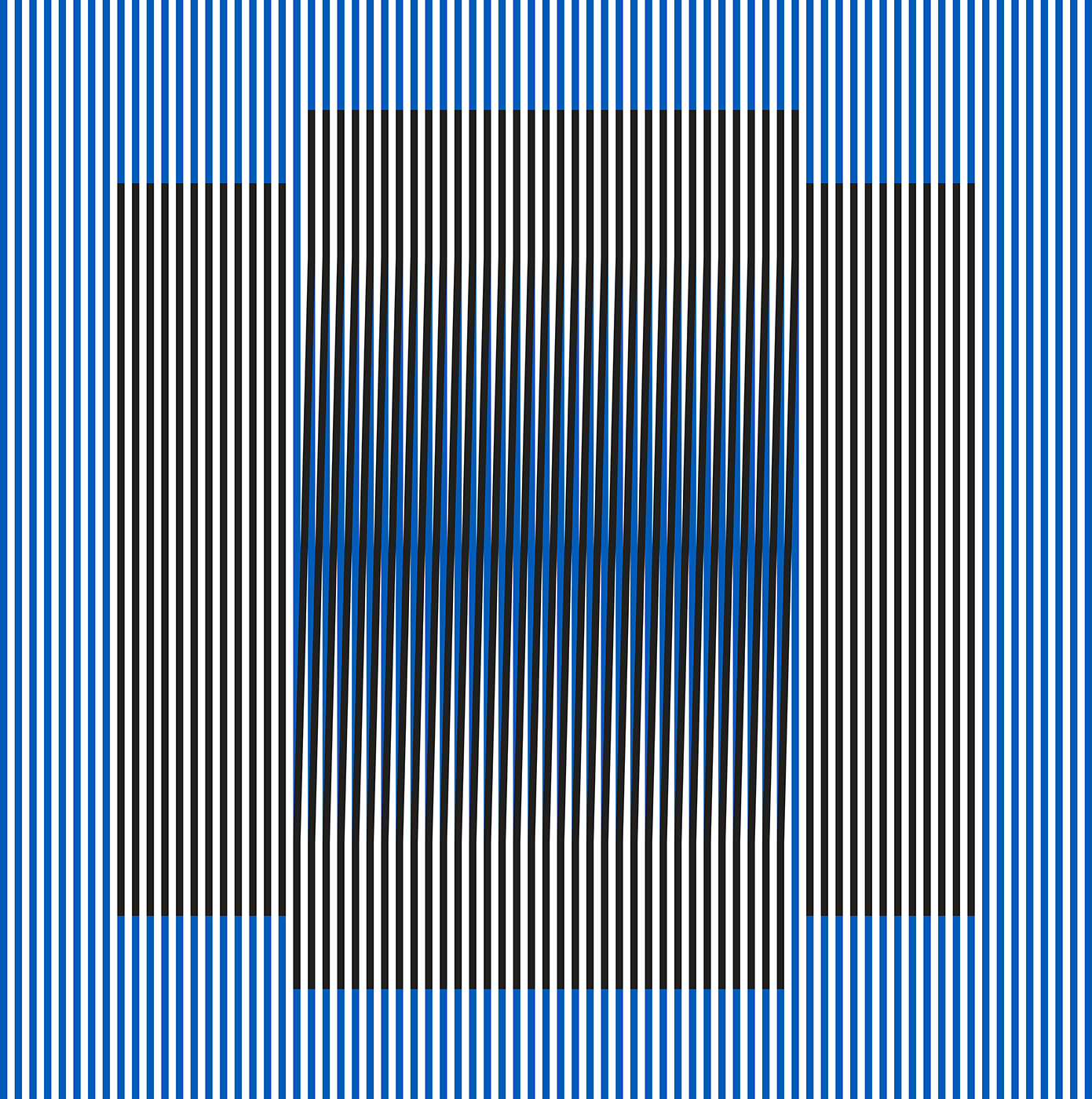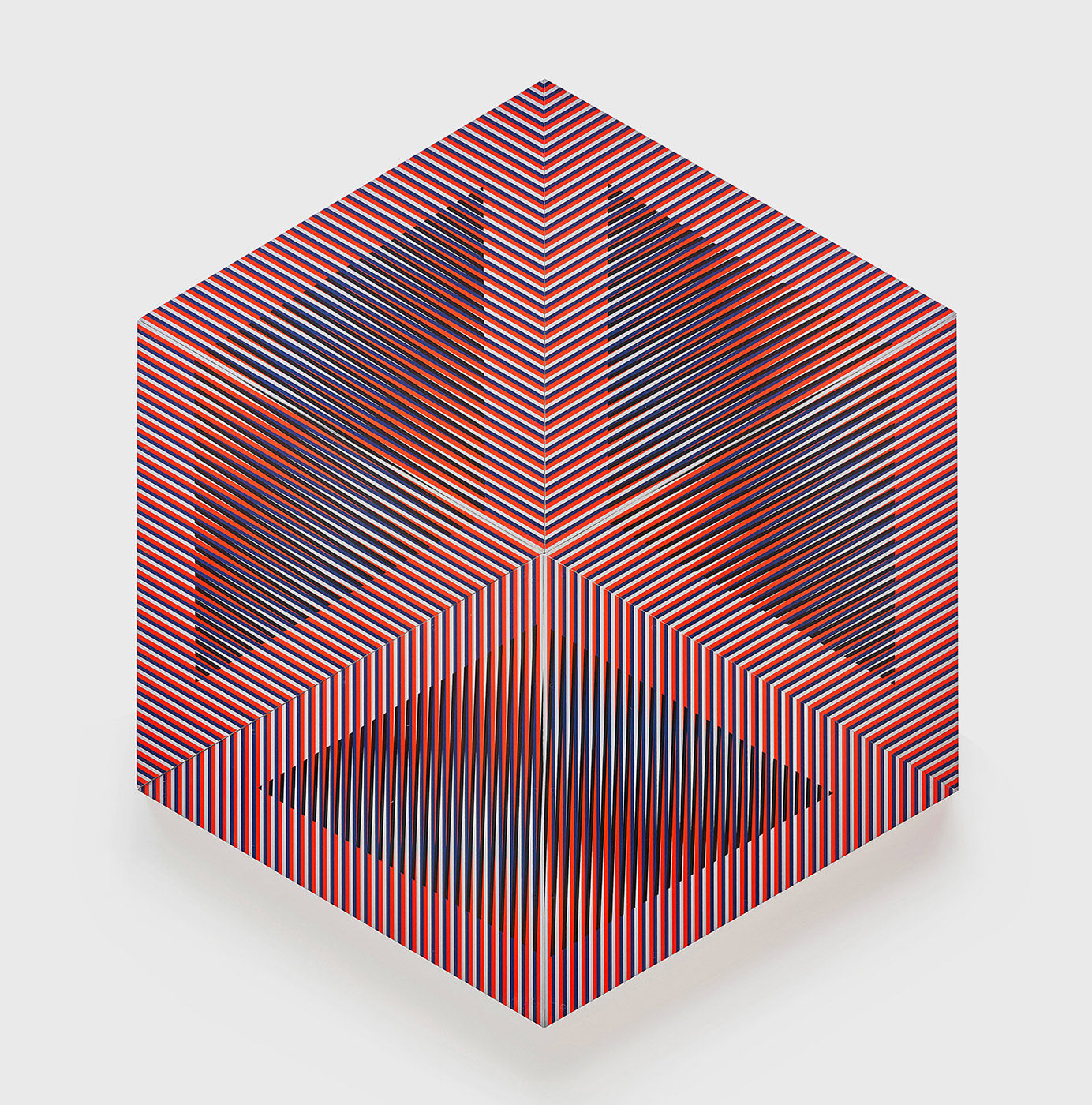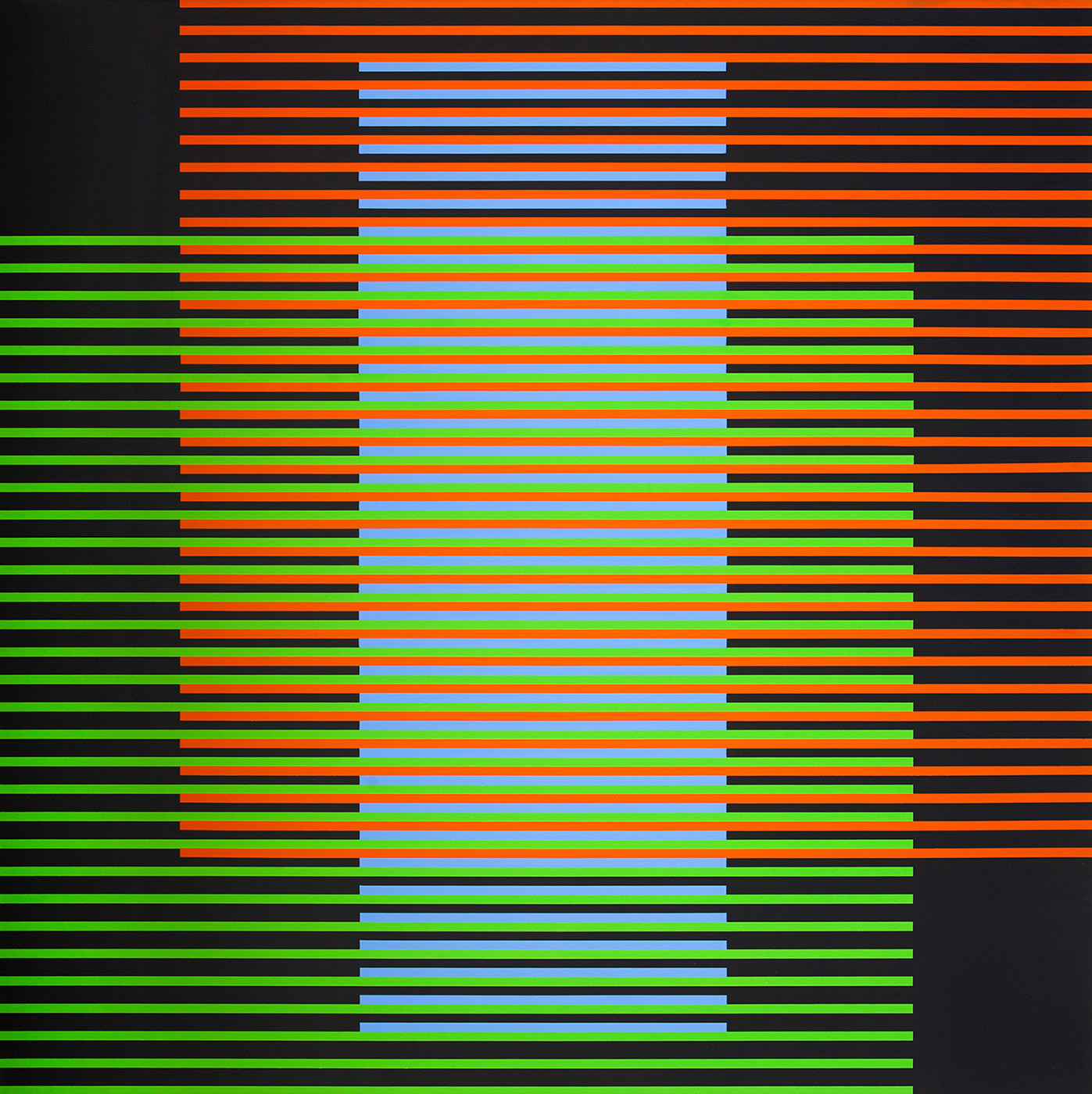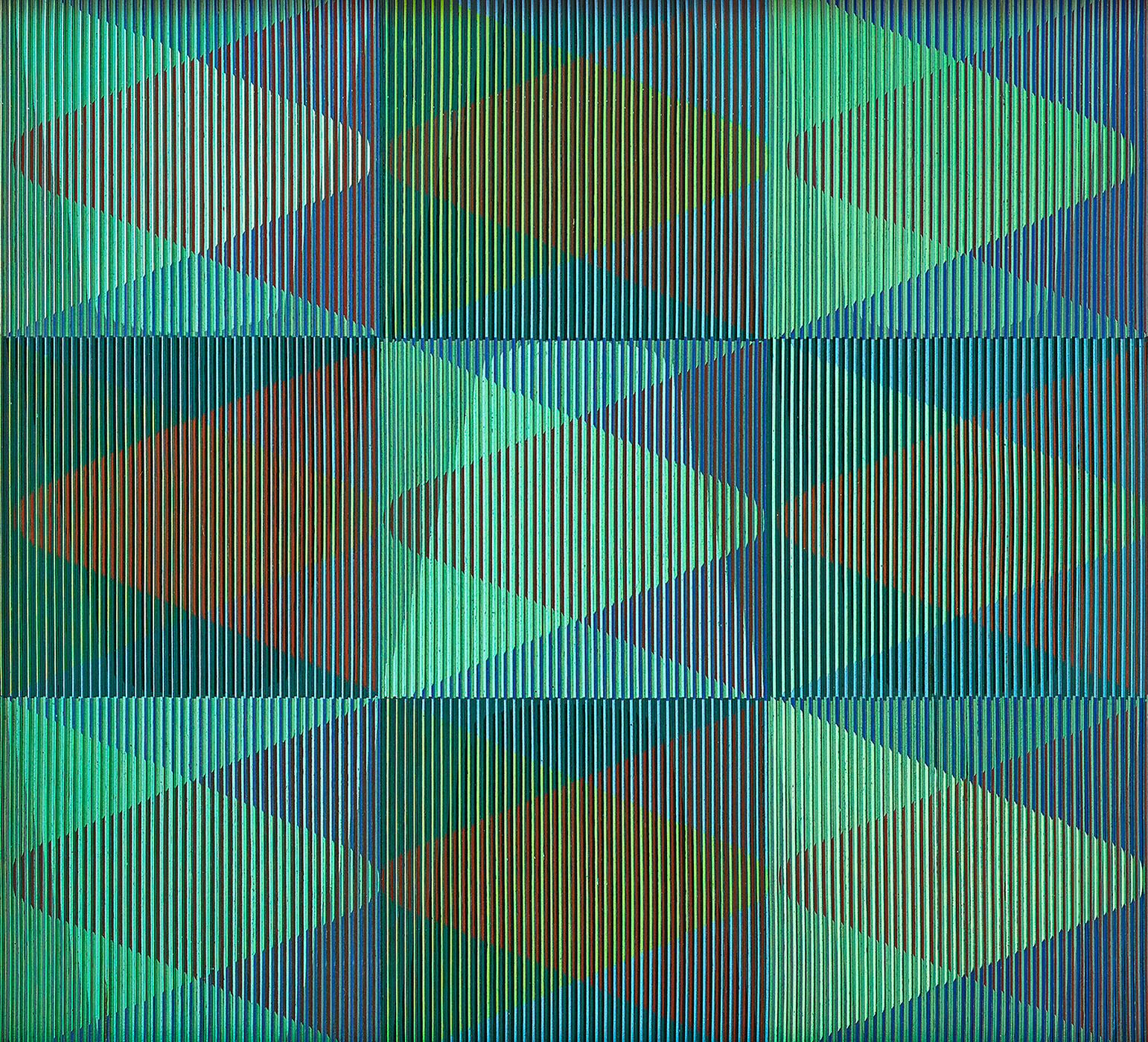Carlos Cruz-Diez inaugurates Phillips’ new exhibition platform

This summer, the London gallery space of Phillips is playing host to a glorious ocular ambush by Franco-Venezuelan artist Carlos Cruz-Diez, one of the founding fathers of the op art movement. A union of art, science and colour phenomena, ‘Luminous Reality’ features previously unseen work, alongside classics, presented as the first show in the British auction house’s new exhibition platform. It includes works from the iconic Physichromies series, notably the motorised Chromointerference Mecanique – whose sister work is housed in Tate Modern – alongside another iteration of his intoxicating Chromointerferent Environment, a four-dimensional gallery-scale chamber saturated with moving projections.
The kineticist encourages active participation in his work, whereby the spectator is both author and actor simultaneously. ‘It has taken me a long time to change people’s perceptive habits,’ Cruz-Diez tells Wallpaper*, having devoted much of his time to rigorously researching the very individual experience of processing colour. At 94 years old, and with seven decades of kinetic art production under his belt, the Phillips catalogue exemplifies the numerous material and conceptual shifts since his emergence in the 1940s.
Represented in international galleries and museums including the MoMA and Musée d’Art Moderne de la Ville de Paris, Cruz-Diez is also renowned for his interventions in urban spaces, including zesty takeovers of pedestrian crossings in Mexico City, Houston and Miami Beach. The artist has been dubbed a pioneer of perception, so much so that ‘kinetic art is to Venezuela what muralism is to Mexico’.

Color aditivo permutable, 1982, by Carlos Cruz-Diez, acrylic on aluminium
Dubbed the ‘master of colour’, his work offers moments for optical escapism. In the early 1950s, Cruz-Diez’s work began to strike a chord with the Venezuelan political elite offering respite from military unrest through its lack of political agenda. In modern times, the artist references society’s aggressive ‘hyperbaroque’ condition in which there are few moments of calm or visual repose, his work proposes chromatic immersion as an antidote.
Cruz-Diez’s methods oppose traditional painting whereby colour is applied once and remains static. Instead, tight stripes of stripped cardboard, aluminium and Plexiglass separate colours vertically to create the moiré effect, three-dimensional illusionary work sensitive to the slightest motion. The artist refers to these as ‘light traps’, where the surface evolves and transforms before the gripped observer.
In recent years, a newfound taste for technology has allowed Cruz-Diez to visualise his creations through simulation, where previously he could only imagine the outcome. ‘Just like a musician with a music sheet, I would spend many days making a piece and in the end if it did not satisfy me I had to destroy it,’ he reflects.
For decades Cruz-Diez’s studio space was former butcher’s shop on Rue Pierre Sémard, Paris, but for the last two years, he’s been operating from a larger workshop down the road, built by his children and reinforced by a team of artists and craftsmen who assist with the execution of his work.
Cruz-Diez shows no signs of applying the brakes: ‘No artist ever thinks that their practice is over. One continues to deepen their discourse to make it more and more dense and expressive.’

Couleur Additive 354, 2016, by Carlos Cruz-Diez, acrylic on aluminium.

Physichromie 153, 1965, by Carlos Cruz-Diez, acrylic and laminated plastic on wood with wooden frame
INFORMATION
‘Carlos Cruz-Diez: Luminous Reality’ is on view until 6 September. For more information, visit the Phillips website
ADDRESS
Phillips
30 Berkeley Square
London W1J 6EX
Wallpaper* Newsletter
Receive our daily digest of inspiration, escapism and design stories from around the world direct to your inbox.
Harriet Lloyd-Smith was the Arts Editor of Wallpaper*, responsible for the art pages across digital and print, including profiles, exhibition reviews, and contemporary art collaborations. She started at Wallpaper* in 2017 and has written for leading contemporary art publications, auction houses and arts charities, and lectured on review writing and art journalism. When she’s not writing about art, she’s making her own.
-
 Nikos Koulis brings a cool wearability to high jewellery
Nikos Koulis brings a cool wearability to high jewelleryNikos Koulis experiments with unusual diamond cuts and modern materials in a new collection, ‘Wish’
By Hannah Silver
-
 A Xingfa cement factory’s reimagining breathes new life into an abandoned industrial site
A Xingfa cement factory’s reimagining breathes new life into an abandoned industrial siteWe tour the Xingfa cement factory in China, where a redesign by landscape specialist SWA Group completely transforms an old industrial site into a lush park
By Daven Wu
-
 Put these emerging artists on your radar
Put these emerging artists on your radarThis crop of six new talents is poised to shake up the art world. Get to know them now
By Tianna Williams
-
 The art of the textile label: how British mill-made cloth sold itself to Indian buyers
The art of the textile label: how British mill-made cloth sold itself to Indian buyersAn exhibition of Indo-British textile labels at the Museum of Art & Photography (MAP) in Bengaluru is a journey through colonial desire and the design of mass persuasion
By Aastha D
-
 Artist Qualeasha Wood explores the digital glitch to weave stories of the Black female experience
Artist Qualeasha Wood explores the digital glitch to weave stories of the Black female experienceIn ‘Malware’, her new London exhibition at Pippy Houldsworth Gallery, the American artist’s tapestries, tuftings and videos delve into the world of internet malfunction
By Hannah Silver
-
 Ed Atkins confronts death at Tate Britain
Ed Atkins confronts death at Tate BritainIn his new London exhibition, the artist prods at the limits of existence through digital and physical works, including a film starring Toby Jones
By Emily Steer
-
 Tom Wesselmann’s 'Up Close' and the anatomy of desire
Tom Wesselmann’s 'Up Close' and the anatomy of desireIn a new exhibition currently on show at Almine Rech in London, Tom Wesselmann challenges the limits of figurative painting
By Sam Moore
-
 A major Frida Kahlo exhibition is coming to the Tate Modern next year
A major Frida Kahlo exhibition is coming to the Tate Modern next yearTate’s 2026 programme includes 'Frida: The Making of an Icon', which will trace the professional and personal life of countercultural figurehead Frida Kahlo
By Anna Solomon
-
 A portrait of the artist: Sotheby’s puts Grayson Perry in the spotlight
A portrait of the artist: Sotheby’s puts Grayson Perry in the spotlightFor more than a decade, photographer Richard Ansett has made Grayson Perry his muse. Now Sotheby’s is staging a selling exhibition of their work
By Hannah Silver
-
 From counter-culture to Northern Soul, these photos chart an intimate history of working-class Britain
From counter-culture to Northern Soul, these photos chart an intimate history of working-class Britain‘After the End of History: British Working Class Photography 1989 – 2024’ is at Edinburgh gallery Stills
By Tianna Williams
-
 Celia Paul's colony of ghostly apparitions haunts Victoria Miro
Celia Paul's colony of ghostly apparitions haunts Victoria MiroEerie and elegiac new London exhibition ‘Celia Paul: Colony of Ghosts’ is on show at Victoria Miro until 17 April
By Hannah Hutchings-Georgiou